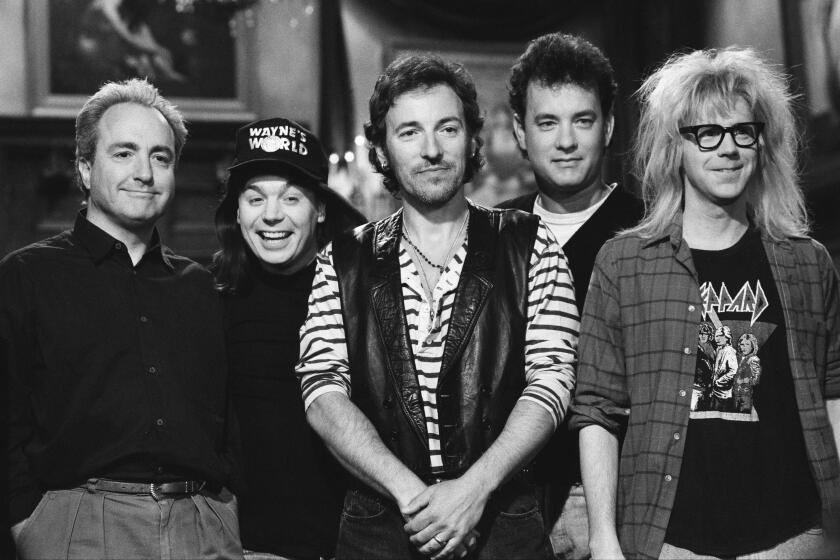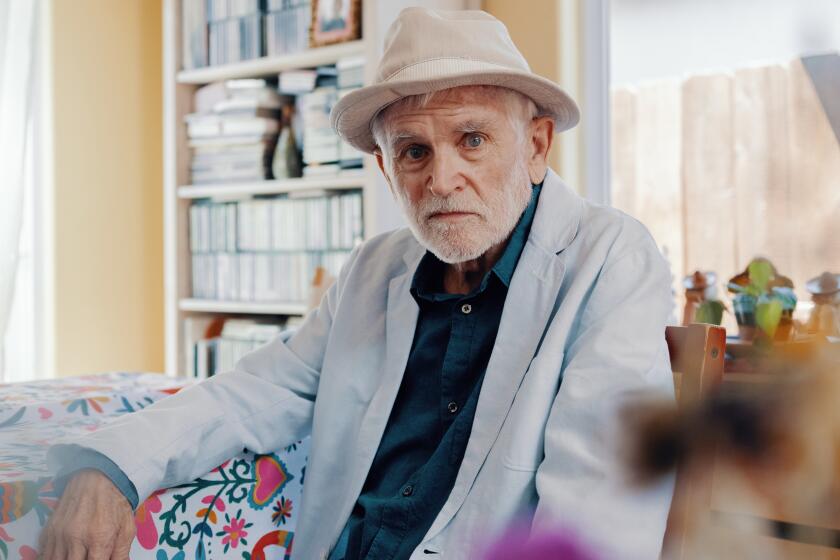Tingles Up and Down Their Spines
- Share via
Ask most writers and they’ll tell you that there’s something special about the novel, a certain weight and texture to the insights it bestows. Perhaps this has to do with the form’s encompassing psychological framework, the way it can bring readers inside its characters’ very hearts and minds. Or maybe what’s at stake is the novel’s lingering prestige as the single achievement to which so many authors aspire.
“I always wanted to write a novel,” says Tara Ison, whose “A Child Out of Alcatraz” (Faber and Faber) was published in April. “It just took me awhile to get it done.”
Ison is one of several Southern California authors to publish a first novel in 1997, which is interesting given the current anxiety in the book business, whose emphasis has turned increasingly to the financial, not the literary, bottom line. In such a climate, industry insiders bemoan the shift toward blockbuster publishing, since large advances paid to celebrity authors are making midlist fiction an endangered species. But while it’s tempting to read the $4.5-million Marcia Clark received for her account of the Simpson trial--or even the $3 million paid to Paula Barbieri for her O.J. book--as symbols of the decline of literary culture, plenty of novels, and even first novels, continue to appear.
In the seven months since “A Child Out of Alcatraz” was published, there have been Yxta Maya Murray’s “Locas” (Grove), Michelle Huneven’s “Round Rock” (Alfred A. Knopf), Sandra Tsing Loh’s “If You Lived Here, You’d Be Home by Now” (Riverhead), Lisa See’s “Flower Net” (HarperCollins) and Joy Nicholson’s “The Tribes of Palos Verdes” (St. Martin’s), to name just a few. “Certainly, it’s difficult to break out a first novel,” says Bob Miller, vice president and group publisher of Disney Book Publishing, “but it always has been. Each year, there are successes in which new brand names emerge.”
Miller’s point is an important one, for publishing, perhaps more than other industries, requires fresh voices to survive. “There’s a definite awareness that you have to replenish,” says Los Angeles literary agent Betsy Amster. “Publishers are always looking for new talent; this business is about the thrill of the hunt.” What’s telling about Ison, Murray, Huneven, Loh and See, however, is the odd paths they’ve taken to become novelists, the ways they operate outside the classic mold.
*
Ison, for instance, is a former screenwriter who spent seven years in the trenches of Hollywood before deciding to write a novel instead. See turned to fiction only after her nonfiction book, “On Gold Mountain,” came out in 1995; prior to that, she worked for 13 years as West Coast correspondent for Publishers Weekly, where she witnessed firsthand the vagaries of a publishing industry in flux. Huneven also spent more than a decade as a journalist, freelancing for publications such as the Los Angeles Times, California and Buzz, while Loh, longtime Buzz “Valley” columnist, published an essay collection and a performance monologue before her novel was issued this fall. And Murray, an associate professor at Loyola Marymount Law School, used her spare time to work on “Locas,” which explores East L.A. gang life from a female point of view.
Of these writers, only Nicholson fits the image of a first novelist. Now 31, the Silver Lake resident drifted through her 20s holding down a succession of jobs and traveling, while publishing poetry and short prose pieces in local zines. She began to work on “The Tribes of Palos Verdes” only after her story “Palos Verdes” was discovered by agent Amster, who encouraged her to try a book. The result is a fairly traditional coming-of-age saga inspired by her less-than-happy experience growing up in Palos Verdes. Nicholson stresses that the narrative is “not purely autobiographical,” even as she admits that its central relationship, between 14-year-old narrator Medina Mason and her twin brother, Jim, reflects her feelings for her own brother Jay, who committed suicide two years ago. “I had pictures of him all around in the room where I work, and it felt like he was there,” she recalls. “I don’t know if writing the book resolved anything, but it helped me relive something and move on.”
Nicholson’s connection to her material is the hook her publisher, St. Martin’s Press, has used to market the book, billing Medina as a female Holden Caulfield and the novel as an updated “Catcher in the Rye.” While that may seem cynical, it’s pretty standard; the idea, says See, is to “establish a foothold,” something that makes your book stand out from the thousands of titles.
In See’s case, it is the fact that “On Gold Mountain,” a history of her father’s Chinese American family, gave her an aura of expertise about Chinese subjects, which, in turn, has bestowed a certain authority on “Flower Net,” a thriller in which an American prosecutor and a Chinese security official team up to investigate a series of murders in Beijing.
“Every review of ‘Flower Net,’ ” she notes, “has talked about ‘On Gold Mountain.’ Although I didn’t consciously plan it that way, it does give the book a bit of a step up.” Still, she says, “It’s not part of an overall career plan. Even now, I’m not thinking that way. It’s just that if you feel you have something to say, you can reach more people through fiction.”
Whether blockbuster publishing is destroying literature in America or the furor is, as Miller puts it, “overblown,” the reality is that presses are no longer inclined to nurture first novelists with the hope that their second or third book might pay off. “It used to be that publishers would build writers book by book, slowly increasing sales,” says Morgan Entrekin, who as publisher of Grove / Atlantic shepherded the year’s most astonishing literary success story, Charles Frazier’s debut novel, “Cold Mountain,” into print. “Now, they want those authors to explode.” The paradox, Entrekin believes, is that in an industry in which sales are tracked by computer, this trend actually helps first novelists because “it’s easier to to sell a first novel than a second or third novel (by a writer who) hasn’t done well.”
This sentiment is echoed by Amster, who calls it “the tyranny of the track record.”
“If a writer doesn’t do well on the first novel,” she says, “a promising career can be made a lot more difficult.” Of course, Entrekin notes, “It helps if an author is mediagenic--young, beautiful and multicultural--since the media is obsessed with what is new.”
*
That’s something See has accessed by taking on her Asian heritage, which is also true of Loh. “I think I’ve benefited,” Loh says of her ethnicity, “even though I haven’t exactly been embraced by the Asian American community and I don’t write about Asian American themes.”
This is not to suggest that, in the current climate, only the most market-savvy novelists can survive. Even See, who earned a substantial advance for her novel, notes that the key to fiction is “following your instincts.”
Murray started the stories that inspired “Locas” because she literally heard her characters talking; as she recalls, “I was watching a news report on the beating of undocumented immigrants in Riverside, and somehow I tripped up on this one voice.” For her, the key connection is between her legal work and her fiction, since, “as a lawyer interested in Latino rights, I spend a lot of time thinking about what it means to be Latino, female, legal.” In “Locas,” those questions converge in one character, who explores them through the filter of a gang.
The gang issue can be touchy; Murray was sharply criticized by journalist Celeste Fremon in the Los Angeles Times Book Review for having bought into the worst stereotypes about Latinos and presenting the culture in a negative light. Murray, however, sees it differently. “Gangs are an icon we use to encapsulate Latino identity,” she points out. “I wanted to tip that on its head. The invisible hand of the marketplace does not help you write.”
*
The notion that the marketplace--or even the idea of the marketplace--is a negative influence is echoed by Huneven, whose passage from fiction writer to journalist and back to fiction writer is something of a metaphor for the journey of self-discovery any serious writer must go through. A graduate of the Iowa Writers Workshop and a recipient of a 1984 General Electric Younger Writers Award, Huneven says she began writing fiction for the wrong reasons. “I wanted to be famous,” she admits. “I was writing to be published, to build a career, but where I ended up was on a route of self-deprivation leading nowhere.”
For Huneven, working as a journalist helped to “desacralize writing. Always in the holy hall of fiction, everything had to be so perfect, so precious, so self-conscious, but with journalism, I wasn’t so impossibly hard on myself.” Equally significant were the two years she spent in the early 1990s as a student at the Claremont School of Theology, where she was urged by a psychologist to stop skating on the surface of life and go deeply into one thing. “No one had ever said that to me before,” Huneven remembers. “And it made me decide to do a novel, after all.” The key was to give up all thoughts of publishing and to write, as she says, “for the reason of doing it. It was a real shift away from how I used to write, when the goal was publication, money, fame.”
*
The same could be said of Ison, who walked away from a lucrative, if not entirely fulfilling, career as a screenwriter to pursue literary fiction instead. Ison’s decision is made more astonishing by the ease with which she moved through Hollywood; two months after graduating from UCLA, she and her writing partner sold a script that was eventually released as “Don’t Tell Mom the Babysitter’s Dead.” “It was fun, and sort of glitzy,” Ison says. “But I hated the industry, the games, the futility. I always got emotionally attached to even the stupidest projects, and it was hard for me to let go.”
Then, on a trip to San Francisco, Ison took a tour of Alcatraz and learned that in the 1940s and ‘50s, prison guards, with their wives and children, had lived in a small community on the island. This sparked the idea for a story about the emotional isolation of a single family, cast adrift in the sullen stillness of the prison world. “Alcatraz,” she says, “is a powerful metaphor, and I wanted to exploit that. To tell the story the way I wanted to tell it, I had to do a novel. It terrified me, but I wanted total control.”
Considering what she’s given up to become a novelist, Ison is philosophical about her choice. “The scale is so different,” she marvels. “What I’ve been paid for my novel is about one-twenty-fifth of what I used to get for a draft of a screenplay. Still, it’s amazing how simply you can live if you don’t have any money. It’s liberating.”
Nicholson agrees. “It’s a trade-off,” she notes. “You don’t get to have nice things, but you have the time to do your work. There’s so much pressure to buy things in the consumer culture, but if you drop out and forget about all that, you can develop the kind of fearlessness you need to write.” Actually, such fearlessness may be the most important element of the entire enterprise, especially if, as Huneven believes, the concerns of literary fiction and the marketplace are inherently at odds.
Thus the decision to pursue a career as a literary novelist remains, as it has always been, a matter of faith. “A person who really wants to write,” argues Murray, “will just write for the joy of it and stop worrying about the other stuff. Although it’s not great for writers to toil in obscurity, it can open a space for creativity and free up the imagination.”
For Loh, it’s all about activism. “Basically, since I rolled into this,” she says, “I’ve taken a ninja warrior approach. Book publishing is just one of many forms I do. It’s a big fight, the whole thing is a big fight, and whatever form seems to be making it into people’s heads, I’ll do it.”
For all that, though, there is still nothing like the lure of fiction, which, more than any other kind of writing, promises, and occasionally delivers, the world. “With fiction,” See explains, “unlike nonfiction, you can sometimes go into people’s souls--not just your characters’, but your readers’ as well.”
More to Read
Sign up for our Book Club newsletter
Get the latest news, events and more from the Los Angeles Times Book Club, and help us get L.A. reading and talking.
You may occasionally receive promotional content from the Los Angeles Times.










